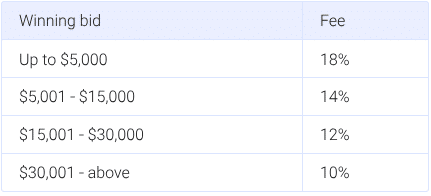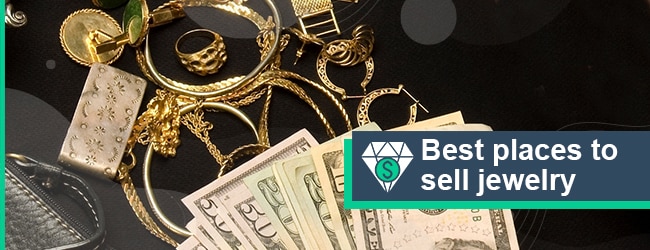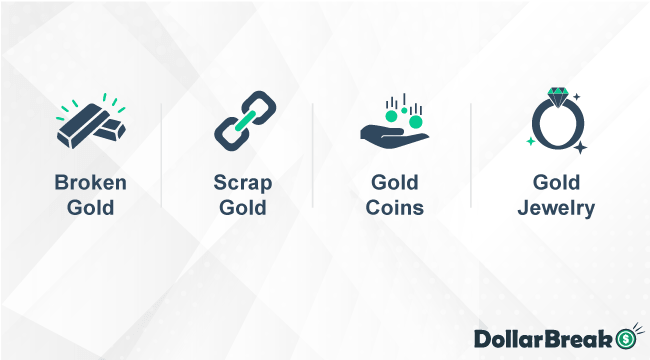Looking to part with old jewelry and get the best return?
We’ll reveal the best places to sell jewelry, whether it’s gold, silver, or gemstones.
Best Places to Sell Gold
CashforGoldUSA
(Our experience selling 2 gold bracelets to CashforGoldUSA)
CashforGoldUSA is one of the best places to sell jewelry made of gold, diamonds, silver, and precious metals. They offer competitive prices for various items, including chains, dental scrap, gold watches, old coins, charms, anklets, and even broken pieces of gold, silver, and platinum.
The company has received an A+ rating from the Better Business Bureau and has paid over $50 million to more than 300,000 customers, demonstrating its trustworthiness. Their appraisal process is simple and takes 24 hours after receiving the jewelry pieces.
To sell, you start by visiting their website and filling out a form. They then send you a fully insured, empty packet for you to pack your jewelry and send back. After verification, the company emails you an offer. If you accept, payment is made via PayPal, check, or bank transfer.
If you decline, your items are shipped back for free.
Express Gold Cash
(Get Paid in 24 Hours)
Express Gold Cash also offers the highest payout for your gold.
They will provide you an offer for your items the same day you submit your application.
The company also guarantees that you’ll get your payment within 24 hours after they receive your package.
In order to ensure the fastest delivery service possible, they provide you a prepaid overnight FedEx shipping label.
Pays 90% of the value of gold bullion & up to 85% of the refined value of gold jewelry.

Best Places to Sell Diamonds
Cash for Diamonds USA
(Payments: direct deposit, PayPal, print-at-home check, or check via USPS or FedEx)
Cash for Diamonds USA is a sister company to CashforGoldUSA and is one of the best places to sell jewelry. The company can buy your diamond pieces such as wedding bands and loose diamonds.
The prices are competitive and vary depending on the weight of your diamonds.
You can benefit from free shipping, evaluation within a day, and better prices. Even though the company doesn’t have accreditation from BBB, the evaluators use industry metrics such as carat, color, cut, and clarity to come up with the best offer for your diamonds.
The process is similar to CashforGoldUSA.
- First, you need to fill a form on the CashForDiamondsUSA website.
- The company ships a package where you mail back your diamond pieces.
- The GIA evaluators check your items and, within 24 hours, contact you with the offer price.
- If you accept, you get paid via your preferred payment option.
WP Diamonds
Although WP Diamonds specializes in selling diamonds, you can also sell your designer jewelry, handbags, and classy watches. The company offers competitive prices and no hidden charges.
You can ship your items within an insurance coverage of $100,000. The company has traded over $100 million and is BBB accredited with an A+ rating. Therefore, you can trust them with a fast and secure process.
The process is akin to CashforGoldUSA and doesn’t involve an auction.
- You start by filling a form on their website, and immediately you’ll receive a mail kit.
- The team then contacts you via phone to explain the sale process. After that, you can send your items for evaluation.
- You’ll receive the offer price, and if you accept, the company will send payment via ACH or bankers’ cheque.
Best Places to Sell Silver
Cash for Silver USA
Cash for Silver USA is a popular remote buyer of precious metals, including silver.
Selling to the company is also straightforward. Use the free mail-in kit they provide to ship your silver items to the company. Once your shipment reaches them, they will appraise it and give you an offer within 24 hours. If you accept the offer, you will receive payment via PayPal, check, or bank wire.
Moreover, the company also buys silver in all conditions and forms, including:
- Silver bars
- Coins
- Silver flatware
- Silver flake
- Paint containing silver
- Silver epoxy
- And any item that has silver at all
JM Bullion
(Minimum purchase requirement of $1000)
JM Bullion is a precious metals dealer that buys and sells silver and other precious metals in different forms. To start selling your silver to the company, you need to create an account on their website. You can then provide information on the silver you intend to sell, after which you will get an offer.
However, note that the company primarily buys private and government-issued bullion coins, bars, and collectible silver coins. Thus, if you have silver jewelry or scrap silver, it is unlikely that you will be able to sell it to JM Bullion.
You should also note that the company has a minimum purchase requirement of $1000. Thus, if you only have a small amount of silver to sell, you can consider an alternative platform on this list instead.

Best Places to Sell Engagement or Wedding Ring
Worthy
(Insurance coverage of up to $100,000)
Worthy is an online auction platform. Its unique operation makes it the best place to sell rings. You prepare your ring for shipping and drop it off at the nearest FedEx location. You can also schedule FedEx to pick it up through the website.
Worthy will cover all shipping expenses and fully insure your item. Once they have your ring, Worthy will clean it and take professional photos. You also need not worry about the next steps, such as putting your item on the live auction.
Worthy does all the selling for you. Once your ring sells, you’ll receive the payment minus Worthy’s commission in the table below, depending on the sales value via PayPal, bank transfer, or check.

PayPal is the fastest option, as you can pay within 2 business days. Meanwhile, check payment can take up to 5 business days.
The steps are easy to follow.
- First, mail your jewelry to Worthy for consideration.
- The company grades the item and prepares it for auction.
- Then, you set the minimum price for the item.
- Payments are made through check, PayPal, or direct bank transfer.

Circa
Circa is among the websites where you can sell engagement rings online. You can visit a Circa store near you by setting up an appointment through their website.
A Circa Specialist will check your ring during your appointment and make an offer. If you are okay with the price, you can receive payment through bank transfer, check, or gift card.
If there’s no Circa store nearby, you can still sell your jewelry to them through the online process. Here, you’ll need to go to their website and provide details about your jewelry. You can also upload photos and supporting documents.
Circa has been in business for 22 years, and in 2019, it merged with Mondiamo to operate as one company. With a BBB rating & accreditation of A+, your jewelry is in safe hands.
The entire process is simple.
- Fill an online form to schedule an appointment.
- Have a private meeting with an evaluator in your location. If none is available, you can sell to an online specialist.
- After review, you’ll receive an offer, and if interested, you’ll get paid via check, wire, or gift card.
Abe Mor
Abe Mor is a website that buys diamonds, making it another of the best places to sell rings. Like other online platforms, WP Diamonds and Circa Jewels, you can get a quick estimate through their website by providing details on your ring.
Here’s how selling your engagement ring to Abe Mor will work:
- Within 72 hours, you’ll receive the initial quote and instructions to send your ring to them.
- After Abe Mor receives your ring, you’ll receive the final offer within 48 hours.
- When you accept the offer, they’ll send your payment as a check through FedEx.
Ruby Lane
The Ruby Lane accepts watches, jewelry, shoes, and pieces of highly-prized furniture.
However, there are fees charged on items. For example, a 6.7% fee on an item capped at $250.
Ruby Lane has been buying and selling jewelry for 23 years and is accredited by BBB with an A+ star rating. Therefore, you can get value for your money by trusting them with your pieces.
You’ll get maximum support throughout the sale process.
- You start by signing up on the website. After verification, a price is set.
- The items are added to the website, and buyers can buy from there.
- Any interested shopper can add to the cart.
- After the sale, the company charges the seller fees and money sent to your account.
Best Places to Sell Jewelry Locally
Pawn Shops in Your Neighborhood
Pawn shops have long been among the most popular places to sell gold. These stores existed for decades before the proliferation of online gold buying companies and websites. Most neighborhoods tend to have pawn shops, and a quick search online will reveal the pawn shops that are nearest to you.
Selling your jewlery to a pawn shop is also incredibly easy and you can do so just by walking into any pawn shop with your gold. Typically, a staff member will appraise your gold on the spot and make you an offer. If you are unhappy with the offer you receive, you can walk away with no obligation to sell.
To find a reputable local pawn shop, follow these steps:
- Do a Google search for “pawn shop in [insert the name of your neighborhood here]”
- Check to see if the options have any reviews from past customers
- Call the pawn shops that you are interested in to see if they are still operating
However, pawn shops need to make money from the gold they buy from you. Thus, the valuation you get from a pawn shop for your gold will likely be lower than its market value. Nonetheless, the convenience you enjoy when selling to a neighborhood pawn shop may be worth it.
Facebook Marketplace
Facebook became the largest social media network, amassing over 2 billion users across 50 countries. In addition to connecting with friends, this platform has added the Marketplace feature, where you can start selling stuff.
As such, you can sell wedding ring after divorce on the platform and not worry about paying listing fees. How much you sell your ring is entirely up to you and 100% of the profit goes to your wallet.
Additionally, Facebook Marketplace offers a safe way to sell since you can check your buyer’s profile to confirm their authenticity.
Finally, creating a listing on Facebook Marketplace requires easy and familiar steps. It’s like creating a public post on your profile, letting you add as many details as needed but limiting photo uploads to 10.
Local Places on Yelp
Alternatively, you can also consider browsing Yelp to find local places that will buy gold. For example, you may find jewelers or second-hand stores where you can sell your gold.
One of the benefits of selling your gold to local places on Yelp is that you can read reviews of these places from past customers. By doing so, you can check whether the shop where you want to sell your gold is legitimate and whether they offer favorable gold prices.
You can also find the most convenient places to sell your gold by sorting the options you find on Yelp based on how near they are to you.
Selling Jewelry For Cash FAQ
Where to sell gold, diamonds, and silver?
When it comes to selling precious metals, gemstones, and jewelry like engagement rings, wedding rings, coins, necklaces, earrings, diamond rings, bracelets, and watches, several options offer competitive prices:
- Online buyers:
- For gold jewelry (necklaces, bracelets, earrings): CashforGoldUSA, Express Gold Cash, SellYourGold.com
- For diamond jewelry (rings, earrings): Cash for Diamonds USA, WP Diamonds, Diamonds Pro
- For silver items (coins, jewelry): Cash for Silver USA, JM Bullion, Kitco Online
- For engagement or wedding rings: Worthy, Circa, Abe Mor
- Specialized dealers: Local jewelers or precious metal buyers often offer competitive rates for all jewelry and watches.
- Auction platforms: Consider Ruby Lane or traditional auction houses for unique or high-value pieces like antique watches or designer engagement rings.
- Local options:
- Pawn shops in your neighborhood (good for quick sales of watches, coins, or jewelry)
- Facebook Marketplace for direct sales of items like engagement rings or bracelets
- Local jewelers (found on Yelp) for all types of jewelry and watches
- Refineries: For larger quantities of gold or silver, including old jewelry or coins.
- Banks: Some banks buy gold and silver coins, though they may not always offer the best rates.
How much will I get for my gold, diamonds, or silver?
The amount varies depending on several factors:
- For gold jewelry (necklaces, bracelets, watches): Expect 70-95% of the spot price. Online buyers like CashforGoldUSA often offer competitive rates.
- For diamond jewelry (rings, earrings): Usually 20-60% of the retail value. Companies like WP Diamonds specialize in diamond purchases and may offer better rates.
- For silver items (coins, jewelry): JM Bullion and Kitco Online typically offer prices close to the spot price for bullion, less for jewelry like necklaces or bracelets.
- For engagement or wedding rings: Worthy and Circa specialize in these items and may offer better prices, especially for designer or high-end pieces.
How to get the most money for gold, diamonds, and silver?
- Compare offers: Get quotes from multiple buyers for your jewelry, whether it’s a gold necklace, diamond earrings, or a silver bracelet.
- Know current prices: Check Kitco Online for gold and silver prices, helpful in selling coins or jewelry.
- Understand your item’s characteristics: Know the purity of your gold or silver jewelry and the 4Cs of your diamonds in rings or earrings.
- Consider specialized buyers: Worthy or Abe Mor for high-end jewelry like engagement rings, JM Bullion for silver coins or bullion.
- Explore local options: Check Yelp ratings for reputable local buyers who can assess your watches, rings, or other jewelry in person.
What is the easiest way to sell gold, diamonds, or silver?
- Online buyers: Companies like CashforGoldUSA offer free shipping kits for sending in your gold necklaces, bracelets, or coins.
- Local options: Pawn shops or jewelers found on Yelp offer immediate cash for items like watches or diamond rings.
- Peer-to-peer platforms: Facebook Marketplace allows for local, direct sales of items like engagement rings or silver jewelry.
- Specialized online platforms: Worthy for engagement and wedding rings, JM Bullion for silver coins or bullion.
Remember:
- Online platforms often offer competitive prices and convenience for selling jewelry like necklaces, earrings, or bracelets.
- Consider specialized services for unique or valuable pieces like antique watches or designer engagement rings.
- Local options can offer quick sales for items like coins or simple gold jewelry but may not always provide the best prices.
- Always get multiple quotes for your jewelry, watches, or coins, and don’t feel pressured to sell if you’re not satisfied with the offers.






